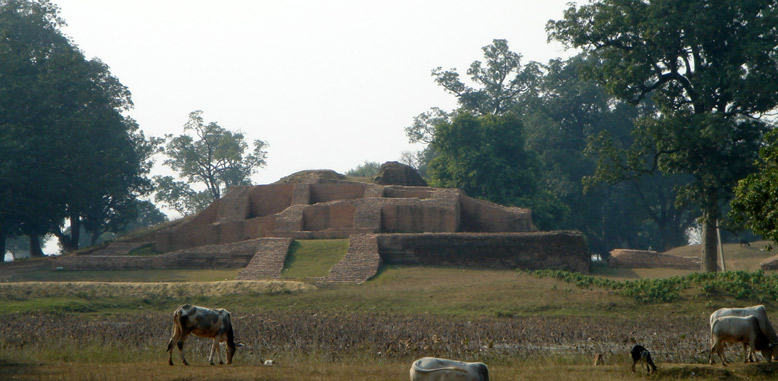The views expressed in our content reflect individual perspectives and do not represent the authoritative views of the Baha'i Faith.
Baha’is believe that Buddhism constitutes a vital part of the divine plan, representing a strong link in the chain of progressive revelation throughout the ages. But how can a religion with scant reference to God be part of the same overall system as the theistic religions? To answer these questions we need to investigate Buddhist history and scripture.
Siddhartha Gautama, the Buddha, was born sometime around 500 BC, give or take 100 years, at Kapilavastu in Nepal. Of the Buddha’s early life a Buddhist scholar writes:
The traditional life story handed down largely in common among all Buddhists is quite full. We may be fairly sure that it contains much accurate information of a historical kind. We are quite sure that it contains later elaboration and additions. What we often do not know is which is which. – L.S. Cousins, A Handbook of Living Religions.

Ruins of the Nigrodharama Monastery near Sidartha’s birthplace and where Buddha stayed during his enlightenment
Some of the stories told of the Buddha sound like myths — but it is always easier to spot the myths of another religion than the myths of one’s own. The greatness of the myths, however, do reveal the greatness of the Buddha in the hearts of His followers. The Buddha, without doubt, was a great being, the Founder of one of the world’s great Faiths, revered and respected around the globe.
As with the stories told of the Buddha, the authenticity of Buddhist scripture has problematic aspects, too. Buddhist teachings were not written down until the first century before Christ – a period of at least 300 years from the time Buddha himself lived. The oldest Buddhist texts were salvaged from Sri Lanka and were written in a language that has come to be known as Pali — though the word just means “text.” The Buddha did not speak Pali; he spoke Magadhi. Pali is a synthetic language, an amalgamation of several dialects, including the one the Buddha spoke. It is not spoken by anyone today save Buddhist devotees and scholars, like Latin from a Western perspective.
Originally, the Buddha’s teachings were divided into nine categories (spellings below vary): sutra (prose), geya (prose and verse), vyakarana (answers to questions), gatha jataka (stories of past births), udana (inspired utterances), itivrttaka (memorable sayings), vedalla (catechism) and adbhutadharma (marvelous qualities), but sometime after the Buddha’s death, a simpler categorization took effect and scripture was divided into nikayas (“volumes” in Pali) or agamas (“scriptural collections” in Sanskrit).
The first volume in those scriptural collections is called the vinaya (in both Pali and Sanskrit) and it contains instruction about monastic discipline. The second is called the sutta in Pali and sutra in Sanskrit. It contains records of the Buddha’s public discourses or teachings (dhamma in Pali and dharma in Sanskrit). Eventually a third volume appeared, called the abhidhamma in Pali and the abhidharma in Sanskrit. These discourses on dharma reflected different understandings of the Buddha’s teachings. Initially many different versions were probably produced, but only two complete versions have survived: one from the Sarvāstivāda school which became dominant in northern India, and central Asia; and one from the Sinhalese school that spread south and eventually to southeast Asia. Together, these three huge volumes of scripture are called Tipitaka in Pali (tripatika in Sanskrit) literally “three baskets.”
We can glean a sense of the immensity of the problem of the authenticity of the Buddhist scriptures from the awareness that the discourses alone make up many thousands of pages, many times larger than the Christian Bible, taking up the equivalent space of at least 50 volumes in modern editions. It is inconceivable that such a huge volume of material could be orally transmitted without modification, alteration or error for hundreds of years before being written down.
Baha’is believe that Buddha was a Manifestation of God, like Christ, but that his followers do not possess His authentic writings. This problem of authenticity plagues many Faiths, including Judaism, Christianity and (to a lesser extent) Islam. But despite that problem, and the parallel problem of the gradual corruption of the authentic and original teachings of each of the Prophets over time, the core teachings of these great religions have a remarkable consistency and congruity:
The real teaching of Buddha is the same as the teaching of Jesus Christ. The teachings of all the Prophets are the same in character. Now men have changed the teaching. If you look at the present practice of the Buddhist religion, you will see that there is little of the Reality left. Many worship idols although their teaching forbids it. – Abdu’l-Baha, Abdu’l-Baha in London, p. 63.
Of course some forms of Buddhism are not focused on idols, but Buddhism, like all religions, is in need of renewal.
You May Also Like
Comments


















If so, then it could also be said that while it's problematic how many sutras there are, it may also hold a more honest picture of Siddharthas own sayings than the Bible has if Jesus, no?
The name Brahmān originates in the historical Vedic religion, in which Brahmān appears as the creator of the universe. Early Buddhist texts describe several different Brahmāns coexisting in the same universe; some of them think they are "all powerful" creators of the world, but they are corrected by the Buddha. The myths, characters, and functions of these Brahmāns are distinct from those of the Vedic Brahmā. However, at least one of the Buddhist Brahmāns is identified as being ...the object of worship of pre-Buddhist brahmins. The Buddha described the Vedic Brahmān as a misunderstanding, or mistaken remembrance, of one or more of the Buddhist Brahmās, as explained in the Brahmajāla sutta (Digha Nikaya 1).
There is no identity between the Buddhist Brahmāns and the Hindu conception of brahman as an all-encompassing divine force.
There are at least four ways of interpreting the term Brahmān. It may refer to:
Any of the deities of the Ārūpyadhātu or of the Rūpadhātu
Any of the deities of the nine lowest worlds of the Rūpadhātu, from Śubhakṛtsna to Brahmapāriṣadya.
Any of the deities of the three lowest worlds of the Rūpadhātu
A Mahābrahmā, one of the highest deities of preceding group.
In the sense of "a being of the Rūpadhātu", the term Brahmā may be related to Brahmavihāra, a term referring to the meditative states achieved through the four Rūpajhānas, which are shared by the inhabitants of the Rūpadhātu.
The old Upanishads largely consider Brahman in the masculine gender (Brahmā in the nominative case, henceforth "Brahmā") to be a personal god, and Brahman in the neuter gender (Brahma in the nominative case, henceforth "Brahman") to be the impersonal world principle. They do not strictly distinguish between the two, however. The old Upanishads ascribe these characteristics to Brahmā: first, he has light and luster as his marks; second, he is invisible; third, he is unknowable, and it is impossible to know his nature; fourth, he is omniscient. The old Upanishads ascribe these characteristics to Brahman as well. In the Buddhist texts, there are many Brahmās. There they form a class of superhuman beings, and rebirth into the realm of Brahmās is possible by pursuing Buddhist practices. In the early texts, the Buddha gives arguments to refute the existence of a creator.
In the Pāli scriptures, the neuter Brahman does not appear (though the word brahma is standardly used in compound words to mean "best", or "supreme"), however ideas are mentioned as held by various Brahmins in connection with Brahmā that match exactly with the concept of Brahman in the Upanishads. Brahmins who appear in the Tevijja-suttanta of the Digha Nikaya regard "union with Brahmā" as liberation, and earnestly seek it. In that text, Brahmins of the time are reported to assert: "Truly every Brahmin versed in the three Vedas has said thus: 'We shall expound the path for the sake of union with that which we do not know and do not see. This is the correct path. This path is the truth, and leads to liberation. If one practices it, he shall be able to enter into association with Brahmā." The early Upanishads frequently expound "association with Brahmā", and "that which we do not know and do not see" matches exactly with the early Upanishadic Brahman.
In the earliest Upanishad, the Brihadaranyaka Upanishad, the Absolute, which came to be referred to as Brahman, is referred to as "the imperishable". The Pāli scriptures present a "pernicious view" that is set up as an absolute principle corresponding to Brahman: "O Bhikkhus! At that time Baka, the Brahmā, produced the following pernicious view: 'It is permanent. It is eternal. It is always existent. It is independent existence. It has the dharma of non-perishing. Truly it is not born, does not become old, does not die, does not disappear, and is not born again. Furthermore, no liberation superior to it exists elsewhere." The principle expounded here corresponds to the concept of Brahman laid out in the Upanishads. According to this text the Buddha criticized this notion: "Truly the Baka Brahmā is covered with unwisdom."
The Buddha confined himself to what is empirically given. This empiricism is based broadly on both ordinary sense experience and extrasensory perception enabled by high degrees of mental concentration. (However it should be noted that amongst the customary epithets of the Buddha are the Pali terms 'lokuttara', meaning 'world-transcending', and also 'lokavidu', meaning 'knower of worlds' which are both quite incompatible with the notion of 'empiricism' as generally understood in current philosophy.)